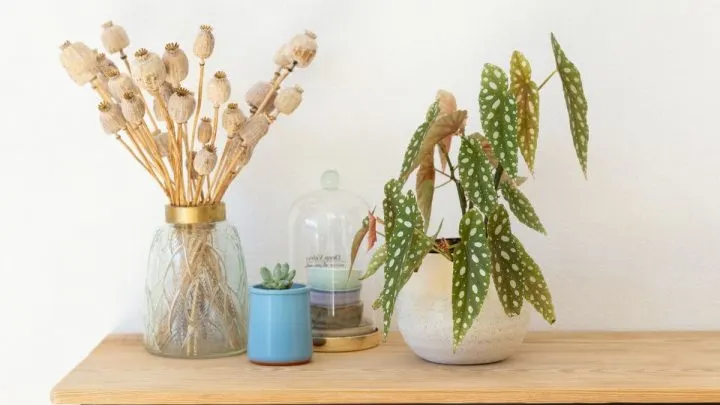Today we will talk about Begonia maculata care and about the specific characteristics that lead plant lovers to buy it. This potted plant is really a beautiful sight and will fit in perfectly any home.
As soon as you see white dots on green leaves, you will immediately consider their location in your home.
However, in order for this plant to grow healthily and happily in your home, it needs a little different care than other types of begonias that you may be used to.
Today, we will therefore go through its care guide, step by step, and explain all the needs of this plant, from light requirements, soil type, reproduction, and other details.
Let’s learn how to grow begonia maculata correctly in our home.
About Begonia Maculata Features And Habitat
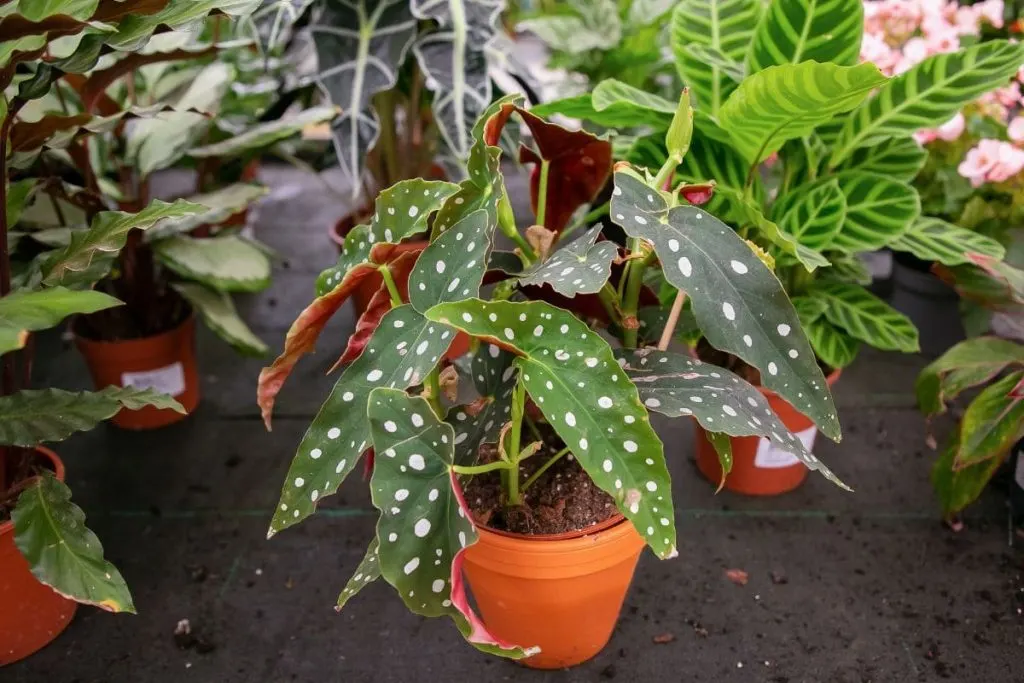
Begonia maculata belongs to the Begoniaceae family, which includes more than 1,800 different species, semi-shrubs, and shrubs.
It grows in its natural habitat in subtropical and tropical climates, and in colder climates, it is grown as a houseplant and is only brought out in summer.
Although they were cultivated in Brazil, Mexico, and China in the 14th century, the first person to document the discovery of begonias was the Franciscan Charles Plumier, who found them in Brazil in 1690. He named them after his favorite botanist, Michael Begon, governor of Haiti.
Due to a large number of species, it is one of the most extensive flowering plants and can range in size from 5 inches to almost 6 feet.
Begonia plant has very low, even creeping species, to those with upright and woody stems, hanging branches and flowers, beautiful leaves, and a variety of shapes and colors of flowers.
Polka Dot Begonia Care Guide
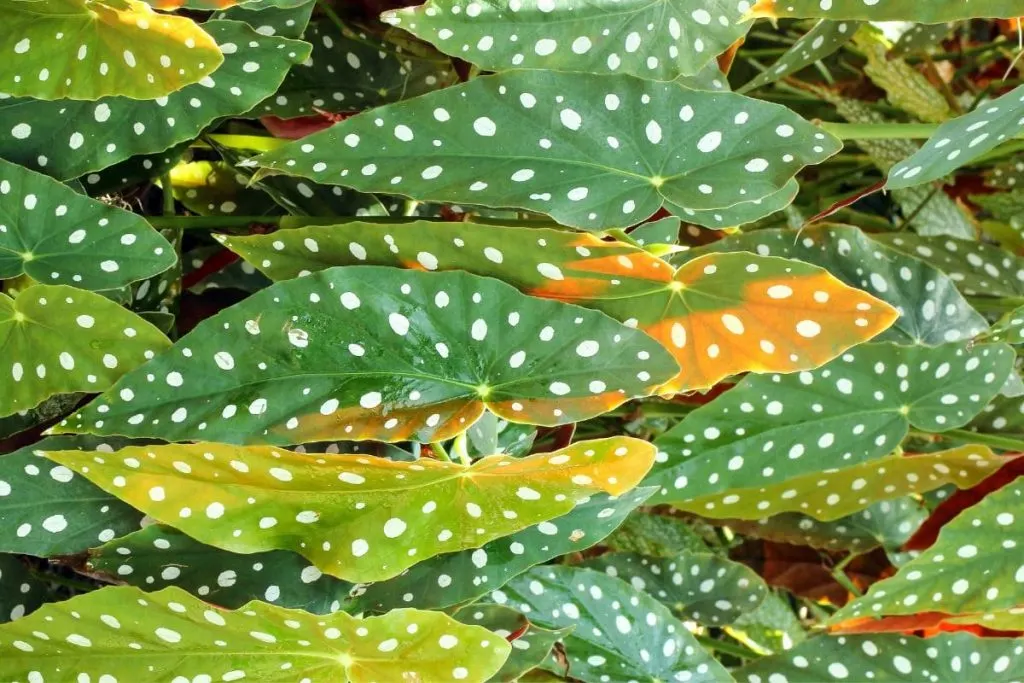
Polka Dot Begonia may be a bit more demanding than ordinary begonia when it comes to caring for this flower.
Because of the bright spots on its green leaves, this plant should be somewhere you see it all the time so that you can keep a close eye on all its changes. Today we will go through its care guide in detail and learn all the conditions that suit this plant.
Let’s read more about polka dot begonia.
1. Light Conditions For Polka Dot Begonia

Since this plant has white dots on its green leaves, unlike a regular begonia, it’s not a fan of direct light. The Begonia maculata likes indirect light, you can always combine it with a bit of shade and that can be perfect for this begonia.
Polka dot begonias can have yellow and brown leaf issues when exposed to too much direct sun. Polka dot plant isn’t a needy plant when it comes to its light conditions, so place it on the west or north-facing window and your begonia maculata will grow and bloom happily.
During the wintertime, when the sun is much lighter and it’s not so threatening to your plan’s leaves as during the summertime, you can place it on a south-facing window. The Winter sun won’t damage your plant.
But, there is a trick, if you can provide them with indirect bright indirect light during the day, even though they don’t like direct sunlight, fluorescent light won’t kill them so you can place them under the fluorescent light without worrying.
2. Water Schedule For Begonia Maculata

Begonia maculata, just like cane begonia doesn’t like too much water because of its thick stems that are too sensitive, and when they’re in too much water, it can lead to plant problems.
Powdery mildew for example appears when there’s so much water when you reach excessive watering etc. Moist soil isn’t the same as overwatered soil.
Water begonia maculata on weekly basis, but only once. If you’re keeping this plant indoors, that can be even more rarely than once a week. However, when you’re growing this plant outside, due to the outside temperatures, especially in the summertime, you’ll have to water it once a week.
You can always do a finger check (put your finger in the soil and see if the first 2 inches are dry or wet) and based on that decide if you should water it.
When it comes to the type of water you should use on this plant, distilled water is fine, tap water is 50/50, it’s your call, but most gardens don’t recommend it for this type, and rainwater is good as well.
3. Begonia Maculata Care: Soil Type
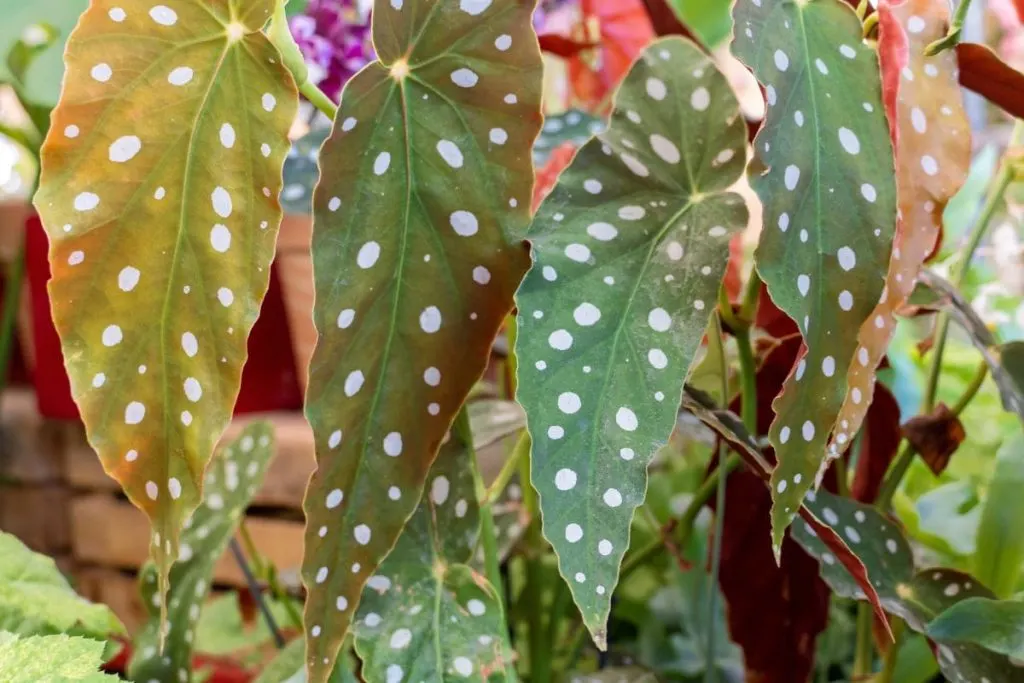
When it comes to the perfect soil type for spotted begonia, you can’t go wrong with a light houseplant potting mix. This potting mix has all the perfect and needed nutrients for polka dot begonia.
Cane begonias like this mix as well. Always use fresh soil for your plant! It’s essential that begonia maculata roots in nutrient soil, generally moist because of course, that affects its growth, health, size, pests, disease resistance, etc. You can also use orchid bark for polka dot begonia.
When it comes to the types of soil you should avoid, peat moss, sand, soggy soil, and humus are not so recommendable. From all of these mentioned, polka dot begonia doesn’t tolerate soggy soil the most.
If you want to see cascading white flowers bloom, use a light houseplant potting mix as mentioned at the beginning.
4. Temperature And Humidity For One Of The Prettiest Begonia Plants
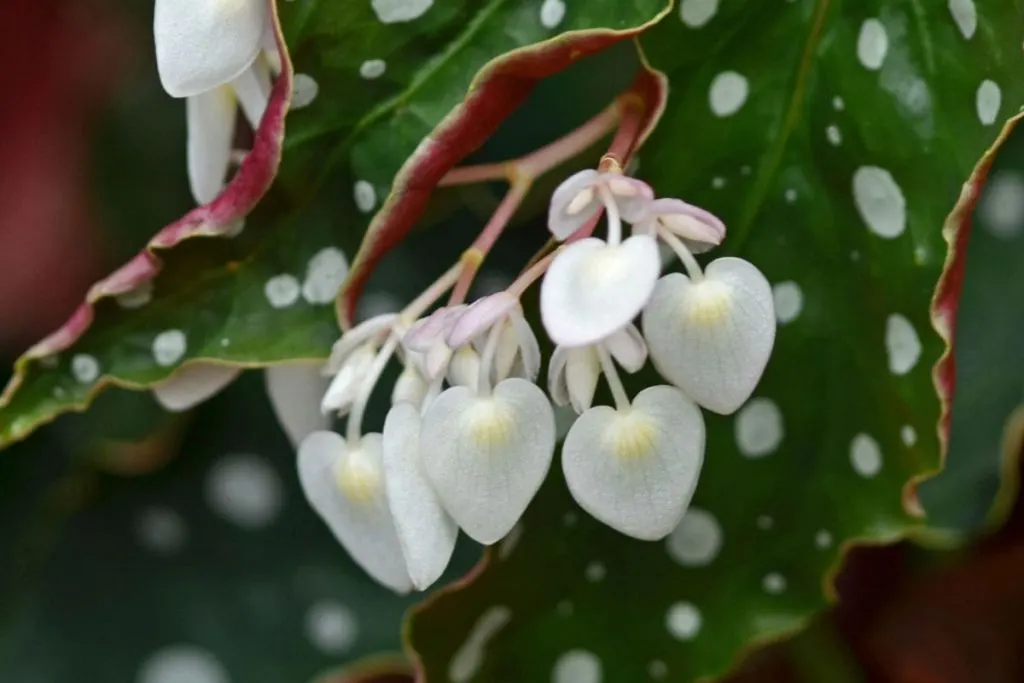
These evergreen perennials hail are naturally from tropical forests where temperatures are pretty high and they’re used to higher temperatures and high humidity.
The optimal range of temperature for this plant should be from 70° to 75°F. Care for begonia maculata isn’t so complicated once you overcome temperature and watering needs, those are definitely the most difficult things about its care guide.
As we said, high humidity is great for this plant. Bathrooms are perfect for this plant, but since the polka dot begonia is so beautiful, you’ll probably want to keep it on a display. Because of that, you can buy an air humidifier and you can keep it in your living room that way.
5. Fertilizer For Polka Dot Begonia
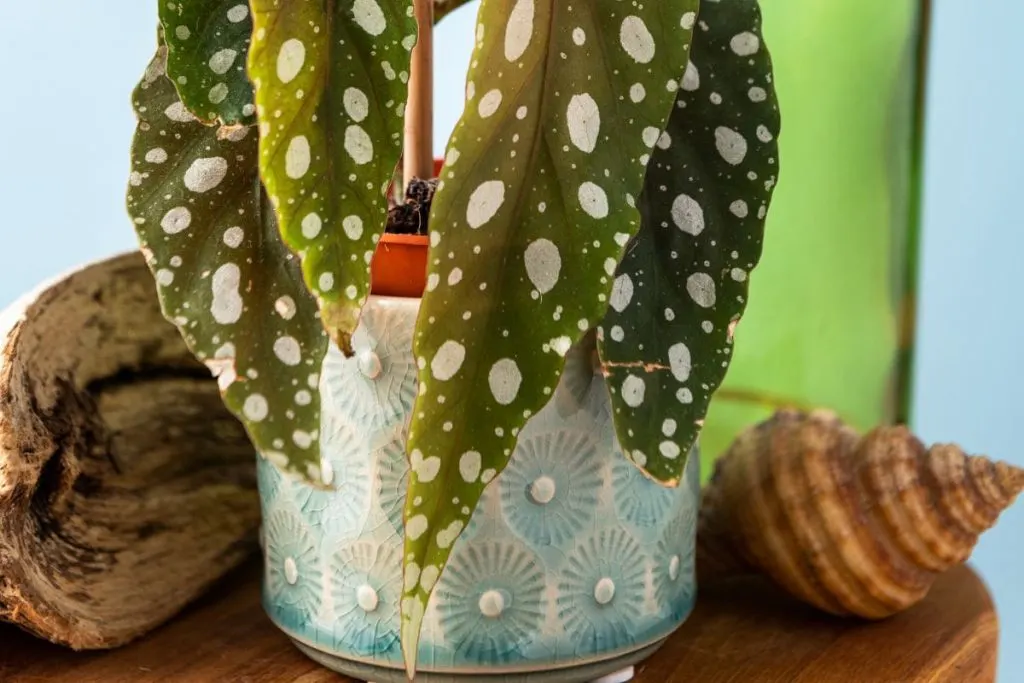
The best fertilizer you can use for polka dot begonia is 20-20-20, mixed at half strength. Don’t use a regular house fertilizer for plants because it simply doesn’t have enough nutrients for the begonia polka dot plant.
Liquid fertilizer isn’t recommendable as well because that would add moisture to your plant and as we said above, too much moisture, isn’t preferable for this plant.
Also, it’s not good for plant’s thick stems to hold too much moisture in. And this can happen once you add liquid fertilizer to the soil.
6. Propagating Begonia Maculata Plant
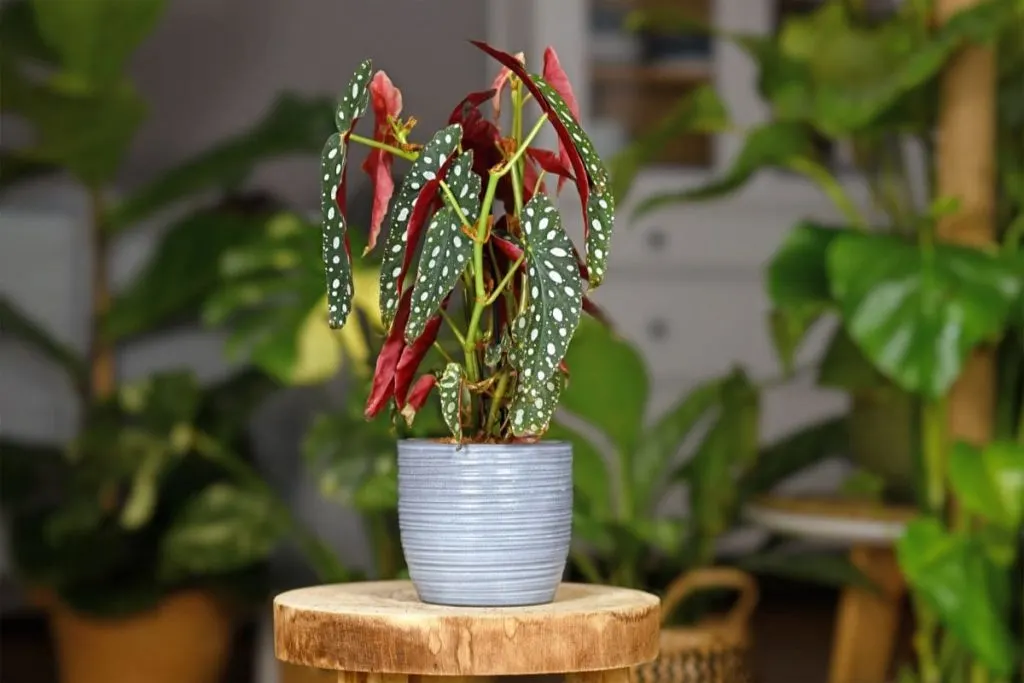
Polka dot begonia propagation can be done in two ways, by stem cutting, and from seeds. You can choose a simpler way for yourself, but both ways are pretty easy and even a beginner can do it. Once you learn how to propagate polka dot plant you’ll have a balcony full of polka dot plants.
All you need is a nice pair of gloves, knife or a scissors, some goodwill, and way to go. Propagation is about to be done. Let’s learn more about these 2 ways of propagating polka dot begonia.
– Propagation Of Polka Dot Begonia From Seeds
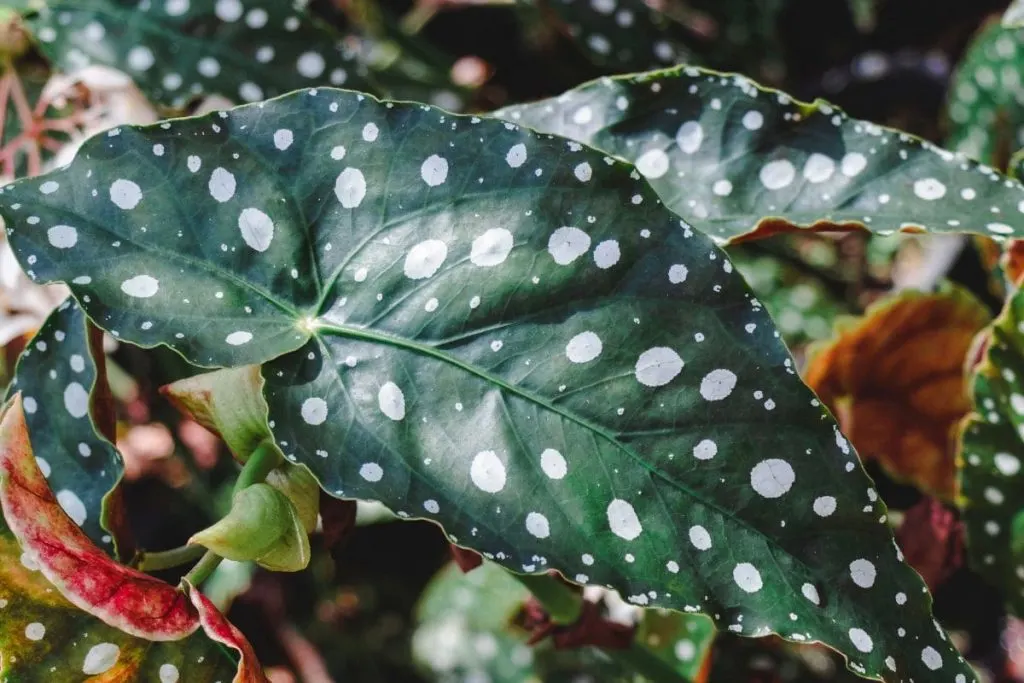
When you decide it’s time to propagate these deep olive green leaves, seeds are a great way to do it. It’s also simple, so, if you want to have fun while doing it, your kids for example can definitely help you. It can be your fun day in the garden. Do it like this:
- always wear a pair of clean gloves;
- broadcast the seeds across the surface of your plant’s soil;
- once you did that, press them on the surface with your fingertips to make sure they’re stuck to the soil (even more important if your polka dot begonia is an outdoor plant);
- don’t cover your pot with anything, seeds need sun and light in this period;
- distribute them evenly in the pot so you won’t have to worry about their growing process later on;
- place your pot on the bright spot and soon enough you’ll see angel wing-shaped leaves.
In about two to three weeks, prepare to see begonia maculata happy plant growing from the soil. Polka dot begonia (also known as trout begonia) might give you pink flowers or white flowers from this perfectly performed process.
– Propagation Of Polka Dot Begonia From Stem Cuttings
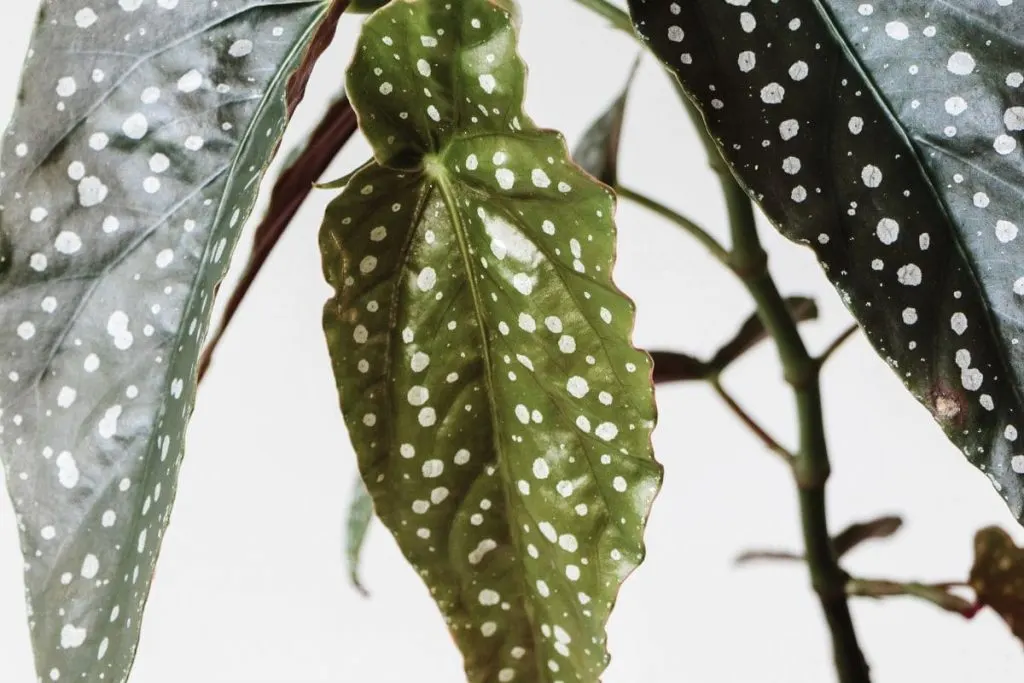
This technique can be used with all begonias plants but is especially useful for houseplants such as polka dot begonias.
For this process, you’ll need a healthy begonia plant and clean the sharp knife and cutting board. Steps for the propagation with stem cutting are:
- Cut young, clean, healthy leaves from the right side of the base.
- Make a diagonal line at the base of the main root.
- Stick the entire leaf onto hard, moist compost.
- Heat and humidity stimulate the growth of damaged areas of the roots.
- Several young plants appear on each leaf.
- Roots and new plants will develop from the vein at the base of each cutting.
- You can split the pot of seedlings and grow them separately or transplant them as a group to produce a bushier plant.
7. Pruning Of Begonia Polka Dot Plant
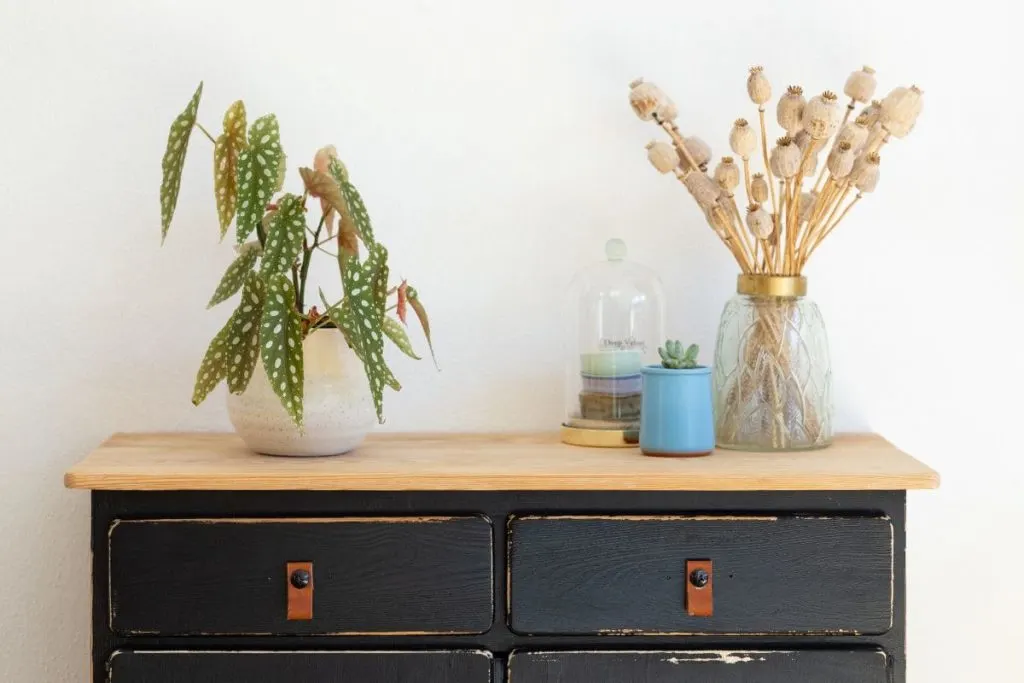
Pruning of this plant is done in two situations: if you don’t want your plant to have a bushy look. Another one is in case your plant becomes a bit droopy, which means that you need to cut off the tips and do some pruning of the brown parts of your plant.
On those spots you’ve pruned/pinched this plant, it will give new branches and you’ll soon have a bigger healthier begonia polka dot. Pruning begonia also creates a chance for their faster and nicer flowering process.
8. Wintering Of Begonia Maculata

When it comes to overwintering begonias, you need to pay attention to several things. Some people have a habit of covering their plants with nylon in winter if they are outside.
This would of course be a smart idea if you live in areas where there is frost at dawn and at night, but since this is a tropical plant that definitely needs warmer temperatures, bring it into the house or basement during the winter.
The plant may not be able to grow and thrive in such regions in general because it likes warmer regions. As long as you prune it in late autumn or late spring, there is no need to do it in winter.
The plant will regenerate in warmer weather and everything will fall into place. The humidity should be reduced in winter though, and as we mentioned above, you can expose it to direct winter sun as it is not as strong as in summer.
Begonia Maculata Common Pests Of Begonia Maculata
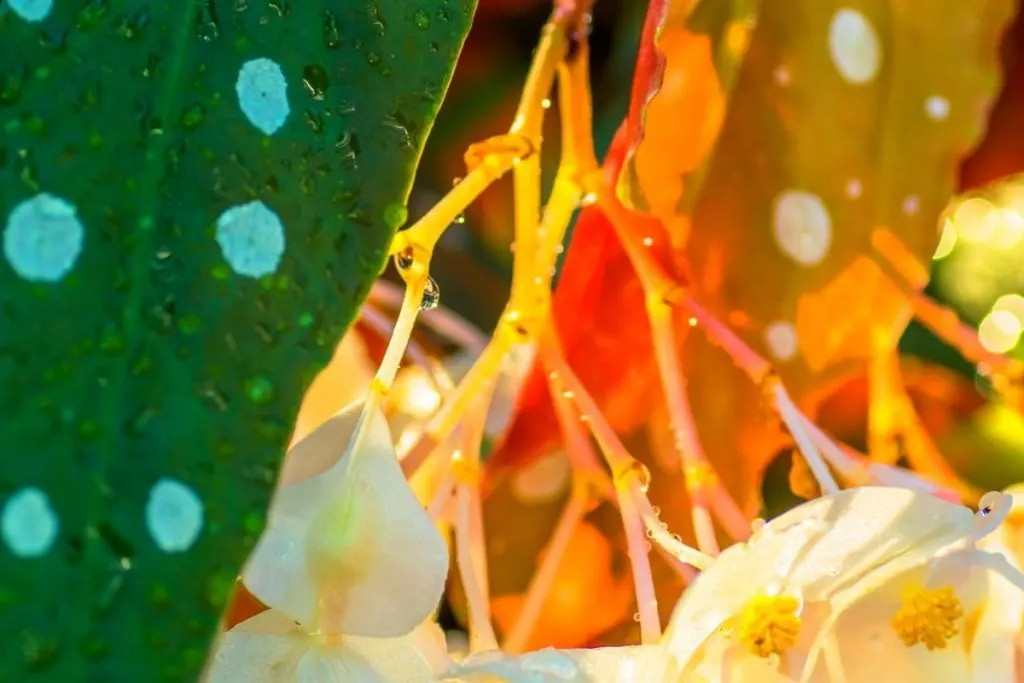
The most common pests that attack begonia maculata plants are mealybugs and whiteflies. If you don’t react right away, these pests will lead your plant to its death. Too much sun and excessive watering are the conditions in which these pests appear on your plant.
- Mealybugs look like tiny fluffs and it will be hard to spot them. I recommend you do a check-up every time you water your plant, just in case. They usually reduce plant vigor, and spots can appear on your plant too.
- Whiteflies are colored insects that will be a bit more obvious, unlike mealybugs. They mostly do damage such as holes on the plant’s leaves, they also suck out the plant’s juice which can lead to your leaves drying out. After they attack your begonia, it might grow poorly after, even when you get rid of them. Leaves might turn yellow as well.
To get rid of these pests, you can use rubbing alcohol, but don’t use too much because it can create a contra effect.
Diseases Of Begonia Maculata
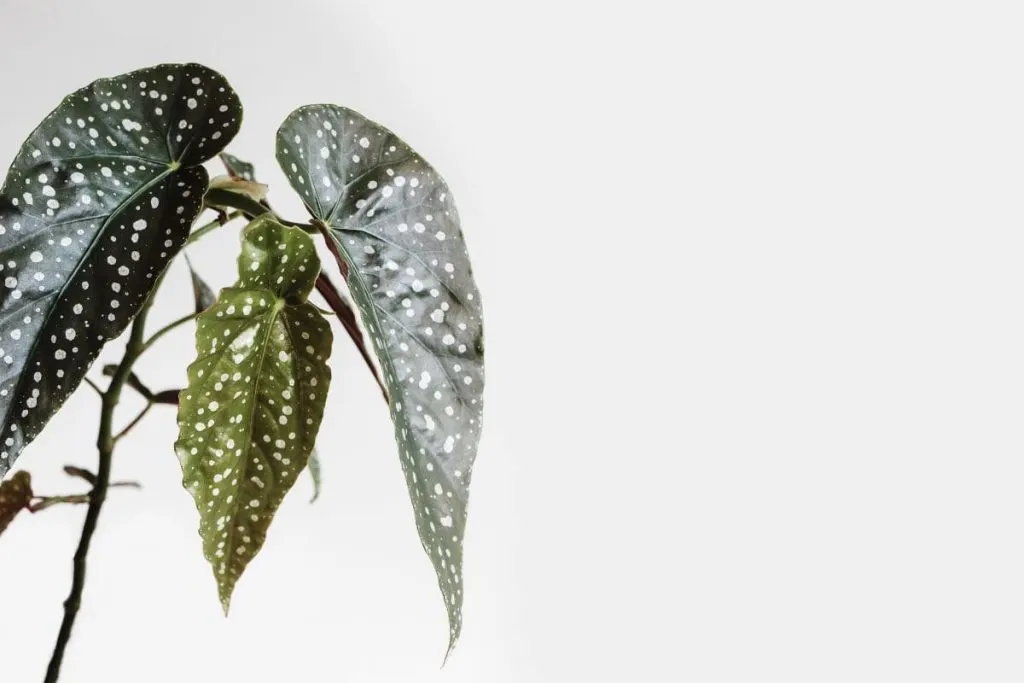
The most common diseases of begonia maculata are bacterial leaf spots, yellowing leaves, brown tips, and root rot.
All of these diseases have something in common and that’s too much water for your plant. Once you water your begonia too much, all of these problems can occur.
These plant’s thick stems hold water in them and once you overwater this plant, the problem appears. You’ll notice all these problems immediately because they are very obvious, Bacterial leaf spot causes spots on your plant, mostly in dark brown and black color.
Yellow leaves will be obvious as well, but don’t think that your plant is drying, you actually overwatered it.
Brown tips are also a problem of excessive watering and sometimes underwatering too. Watering is a tricky little thing with this plant, so be careful and keep up with your watering schedule!
Root Rot Issues On Polka Dot Begonia
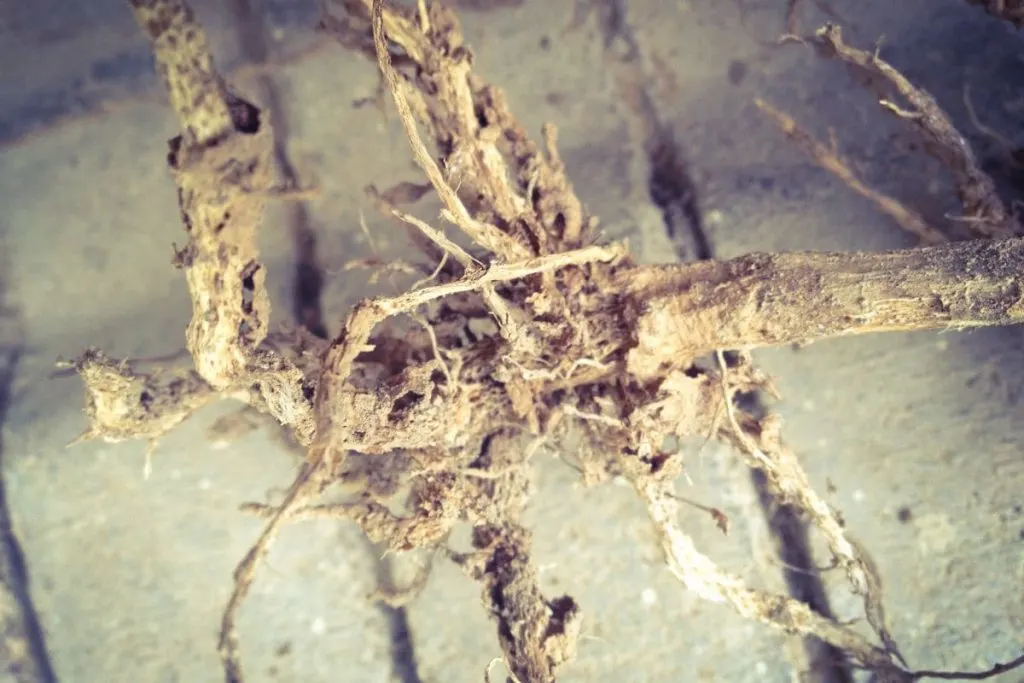
Root rot is a common problem with these plants. If your begonias are infected, you’ll probably want to know more about it. It is a disease caused by the fungal organism Pythiumultimum.
This organism lives in the soil. It becomes active when the soil is very cold and the weather is cool. Pathogen spores travel in water and spread when soil is invaded. When begonia stem and root rot infects your plants, they will likely show a variety of symptoms.
These include darkened leaves, blackened and rotting roots, rotting stems just above ground level, and crown collapse. Begonia root rot usually kills seedlings by suffocation. It often leads to the death of mature plants.
To avoid begonia stem and root rot infection, avoid overwatering and never apply water to leaves or place the end of a hose on the ground. It is also wise to avoid over-fertilizing plants. Keep plants far enough apart to allow for excellent aeration. Use a fungicide, but regularly rotate the type you use.
FAQ – Begonia Maculata Care

As every time so far, we always try to give you all the answers regarding a certain plant. Considering that today we talked about begonia maculata care, there are still some questions about this spotted flower that we didn’t answer above.
Let’s find out something else interesting about this type of begonia.
Is Begonia Maculata Toxic?
Although you can keep it in the same room where you live, if it comes into direct contact with sensitive skin and juices from this plant, it can cause irritation and even vomiting.
For this reason, and considering that our paw friends are often curious, keep it at a height that is out of reach of your pets or children.
Does Polka Dot Begonia Maculata Go Dormant?
We have mentioned several times in this article that this plant originates from tropical regions and does not tolerate low temperatures well. When you learn how to keep plants warm in winter your lovey begonia maculata leaves won’t have any issues.
Since its optimum temperature range is 70 to 75 F, when exposed to low temperatures, this plant becomes dormant. Polka dot begonia prefers warmer temperatures, areas where spring and summer temperatures are common, are the best areas for this plant.
However, do not worry, if this condition does not last long, your plant will quickly recover from the temperature shock and come to its senses as soon as it is placed in a warmer place.
Is Begonia Maculata Hard To Care For?
After reading the entire guide for the care of this plant, I think we can conclude that this plant is partially demanding to care for.
However, we have to pay attention to some details more than with other houseplants, but once you master it once, just once, it becomes a routine like everything else.
If you have houseplants, and I’m sure you do, then you’ve gone through most of it and have nothing to fear. Get this wonderful plant and enjoy its charms. If you are not sure about something, read our care guide once more and remind yourself how something is done.
Is Begonia Maculata A Good Indoor Plant?
Begonias are good outdoor and indoor plants. It’s really up to you. If you care for begonias, it doesn’t matter if you grow them outside or inside.
But of course, some types are less resistant, some more to certain weather conditions and environments. Another beautiful type of begonia to grow indoors is begonia white.
This particular begonia we are talking about today, begonia maculata is a very good indoor plant. She is more suited to indoor conditions than to outdoor conditions.
How Do You Get Begonia Maculata Wightii Bushier?
Pinch the stems back to a healthy bud from the tip. This process can be repeated 2-3 times at approximately 4-week intervals to drive maximum business.
Some people think that fertilizer can help your plant to grow faster and bushier, but nothing can affect its bushy leaf features besides pruning.
A pinch causes the begonia to branch out, creating more stems, leaves, and flowers. If you wanted your begonia to be bushier, this will definitely do it and you’ll see a change really soon.
Final Thought On Begonia Maculata

We’ve come to the end of another plant care guide article. Today it was begonia maculata care. I think we can conclude, when we summarize and arrange everything, that this plant is not as demanding as it seems at first thought.
When you adopt the basic things, its care soon becomes a daily routine, and while this beautiful plant blooms peacefully in your home, you will feel that it does not take so much of your attention.
If you skipped some parts and did not read them carefully, let’s repeat them. This plant needs bright filtered light, lighthouse potting mix, mild fertilizer, never liquid, and watering once a week. It is propagated with seed and stem. Both ways are simple, the choice is yours. Everything we said above in detail can fit into two simple sentences.
Have you remembered everything now? I hope so! See you soon!

